A Field Report from Samden Sherpa
Managing Director Snow Leopard Treks, T-Help and WINTA Network Member
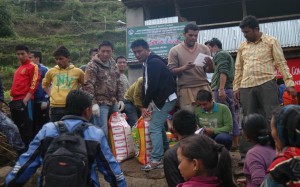 This earthquake has been especially unfair because it has hit Nepal’s poor districts and the poorest the hardest. The entire country has been traumatized by the earthquake and damages to life and property are extensive.
This earthquake has been especially unfair because it has hit Nepal’s poor districts and the poorest the hardest. The entire country has been traumatized by the earthquake and damages to life and property are extensive.
Moreover, a closer assessment of the damages show that communities that have been hit the worst are from the indigenous and Dalit communities from the districts of Gorkha, Sindhupalchowk, Nuwakot, Dhading, Ramechhap, Rasuwa and Dolakha. The indigenous and Dalit communities are poorer and are less likely to receive relief earlier on since they have less access to the road network—villages of indigenous communities in Nepal are usually further away into the hinterland and so geographically disadvantaged in terms of access to relief. Moreover, most indigenous and dalit communities and villagers lack access to state mechanisms and so do not have the necessary cronyism required in most third world country to be prioritized for relief. To make matters worse, some of these communities are cashless villagers whose houses, livelihood in terms of cattle are also destroyed. Some Dalit community members are also landless.
Government estimates show that 8,463 people have died and still counting as recue process is ongoing, with more than double that amount injured or disabled from the massive earthquake. 600,000 homes have been destroyed, 20,000 schools lay in ruins and shelter is required for 4 million people resulting from the 7.9 earthquake on April 25. The government has not even estimated the deaths, injured and destruction after the 7.3 second earthquake on Tuesday, May 12.
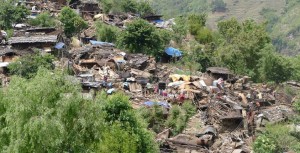 International Aid agencies and the government have been slow to respond due to their need to work though administrative and procedural protocols and as a result of absence of harmonious coordination between international aid agencies and the government.
International Aid agencies and the government have been slow to respond due to their need to work though administrative and procedural protocols and as a result of absence of harmonious coordination between international aid agencies and the government.
Whereas we operate as local volunteers and have therefore been quick to respond to help and have been able to expand our loose network of volunteers very rapidly. We have been targeting relief to the poorest communities that might face starvation during this time. Until the 8th day of the quake our loose network of volunteers probably delivered more relief supplies to needy and remote villages with mostly indigenous communities than the Government and international agencies—as they were caught in bottlenecks, red tape and lacking in delivery mechanisms.
I have been out in the villages since the second day of the quake whereas most international media were only covering KTM and its historical monuments till atleast a few days more after the quake. The most disastrous areas and people who needed help the most were clearly forgotten or ignored in the relief and coverage process.
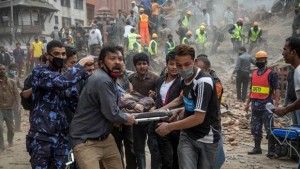 The coming days are a huge challenge in Nepal’s relief work as the monsoon has crept in causing landslides and obstructing accessibility to remote hill and mountain villages. Indigenous communities that live in the hinterland will again be the most to suffer. There is also threat of a health epidemic as dead carcasses of cattle are still buried under the rubble of devastated houses. Also, experts predict glacial lake outburst floods due to continuous tremors that are still being felt. In addition, most highways have been damaged due to the massive quake causing nightmares to logistical transportation.
The coming days are a huge challenge in Nepal’s relief work as the monsoon has crept in causing landslides and obstructing accessibility to remote hill and mountain villages. Indigenous communities that live in the hinterland will again be the most to suffer. There is also threat of a health epidemic as dead carcasses of cattle are still buried under the rubble of devastated houses. Also, experts predict glacial lake outburst floods due to continuous tremors that are still being felt. In addition, most highways have been damaged due to the massive quake causing nightmares to logistical transportation.
Tourism has also been badly hit. The Langtang Valley with 450 households is a primary trekking destination in Nepal and has unfortunately been totally wiped out. Avalanches are ongoing and the trails have been totally destroyed. The indigenous people of this region are totally dependent on tourism and now the challenge is to reconstruct the Langtang trek.
There are also some positives to this earthquake. In the aftermath of the quake, the government was stagnant but the young people of Nepal were quick to organize, unite and volunteer in the relief process. The spirit of volunteerism, solidarity in crises is exceptionally high. The Nepal Army and Police deserve all the applause for their continuous work of rescue and relief. Government utilities such as electrical power, telecom has been in smooth operation allowing people to connect in times of crises. The biggest positive is the continued integrity of Nepal’s villagers that have confident in their skills, values and ability to overcome this crises as they have overcome so many other crises in the past.
The Way Forward
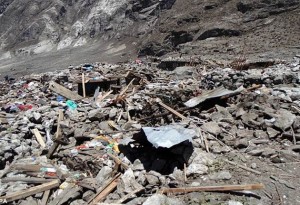 The short term challenge is to continue to provide food, tent or transitional shelters, and their livelihood up and running as relief to inaccessible villages to avoid starvation and homelessness. Indigenous communities are most vulnerable as they are mostly further distant from road networks, in remote villages. The challenge is also to ensure that the vulnerable such as women, children, old, widows and disabled people are properly rehabilitated along with entire communities.
The short term challenge is to continue to provide food, tent or transitional shelters, and their livelihood up and running as relief to inaccessible villages to avoid starvation and homelessness. Indigenous communities are most vulnerable as they are mostly further distant from road networks, in remote villages. The challenge is also to ensure that the vulnerable such as women, children, old, widows and disabled people are properly rehabilitated along with entire communities.
The short term is the coming two months period before monsoon hits in late June.
The medium term is the two months to 6 months period. Nepal’s challenge in this period is to provide transitional shelter, restart health posts and schools and also help villagers rebuild their livelihood by providing seeds, cattle, mills etc.
Designs homes would have to use local materials, local labor and advanced engineering expertise. More importantly indigenous communities would be consulted extensively and they would be given leadership in the entire process so that their traditional knowledge system is given precedence in the process. We are only providing moral and some material support from the outside. More importantly we will be learning from these communities as we help them rebuild.
The longer term challenge is to reestablish their livelihoods such as pastoralism, tourism, agriculture through proper mechanism and to reconstruct their homes.
It is of paramount importance that the indigenous skills and wisdom of village people are conserved and utilized in the reconstruction process. Some agencies are even debating large scale reconstruction and resettlement of villagers. I fear that this would not only destroy the identities of our indigenous cultures but this approach only looks at the village communities as victims of a quake and not as empowered nationalities that have a distinct culture and knowledge systems.
Villagers in Nepal have always been highly skilled and self-sufficient. Village people have always been more skilled at building homes, making irrigation canals, doing agriculture and raising their cattle. Moreover, their community network is very strong and the system of mutual aid is very present in Nepal. To think of resettling indigenous communities in larger communities and seeing them as a figure of GDP only, or to not consider their wisdom, knowledge and skills in the rebuilding process would only do further injustice in addition to the quake.
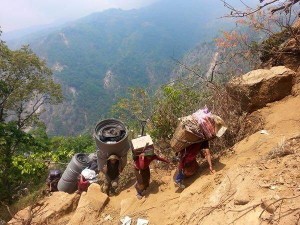 We need partners that share T-Help and Snow Leopard’s vision to participate in village development by putting indigenous communities at the centre and acknowledging that conservation of their cultures, knowledge systems and skills is as important as physical reconstruction. Moreover, indigenous communities would need to be consulted and their voices would need to take leadership so that they not only own the projects but their wisdom, knowledge and traditions are central to the design and implementation of the projects.
We need partners that share T-Help and Snow Leopard’s vision to participate in village development by putting indigenous communities at the centre and acknowledging that conservation of their cultures, knowledge systems and skills is as important as physical reconstruction. Moreover, indigenous communities would need to be consulted and their voices would need to take leadership so that they not only own the projects but their wisdom, knowledge and traditions are central to the design and implementation of the projects.
We would like to call on like-minded partners to participate in any of the fields of housing, health services, school reconstruction, livelihood generation, supplying relief from the short, medium, to long term. T-Help has been working in several affected villages from before the quake and we will be looking at a bigger role in village development in the villages that we have been active in.
We will get a more detail proposal out in a few weeks after we have been able to get through the rapid relief process of distributing food and tents.
Currently, I am planning on an expedition with around 200-300 porters to trek 6-7 days to the remote mountain villages of Upper Gorkha to provide food relief and tents. These villages are totally inaccessible by road and due to the monsoon, they most likely will not receive any aid.
Samden Sherpa.
Two Opportunities For You To Make a Difference
If you wish to make an immediate donation of funds for T-Help’s work with villagers in the Sindhupalchowk District, then please make a donation via http://himalayanstoveproject.causevox.com/yankila-sherpa
If you have an ongoing interest in partnering or supporting T-Help/Snow Leopard Trek in their forward journey to ensure that Indigenous communities are centrally involved in the development of their villages, please provide your contact details to [email protected] .
